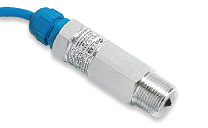ATEX Sensors
ATEX Sensors or flame-proof thermocouples and resistance thermometers have been designed for temperature measurement in all explosion zones of gases, liquids, fogs and dust. The flame-proof head may have one or two cable glands and may be equipped with terminal block or transmitter. The use of optoelectronic sensors in potentially explosive areas requires specially protected devices. This range of sensors are for use in environments of inflammable gases, fumes, chemicals, powders, dust etc. found in many industries. They will allow engineers to monitor vibration levels of pumps, fans, compressors, motors, conveyors, drilling rigs and all types of rotating machinery, which are in a potentially explosive working environment.
Common Types
Compact sensors for zones 2 and 22 in stainless steel
The sensors are developed for all category 3G and 3D applications. With their small dimensions, they fit even in constrained spaces. The sensors and the protective housing are made of stainless steel and are also suitable for demanding operating conditions.
Commonly available are retro-reflective photoelectric sensors and scanners with background suppression. The temperature class for explosive gas areas is T4; for explosive dust areas it is 70°C.
Powerful sensors for zones 2 and 22
Due to their high performance reserve, these devices are used for reliable detection even with heavy soiling in category 3G and 3D applications. The product spectrum encompasses familiar operating principles such as throughbeam photoelectric sensor, retro-reflective photoelectric sensor or scanner with background suppression. The temperature class for explosive gas areas is T4; for explosive dust areas it is 90°C.
Long-range sensors for zones 2 and 22
These sensors were specially designed for applications that require large ranges in categories 3G and 3D. The product spectrum includes all operating principles, including a category 2 protective photoelectric sensor (testing). The temperature class for explosive gas areas is T4; for explosive dust areas it is 70°C.
Video
